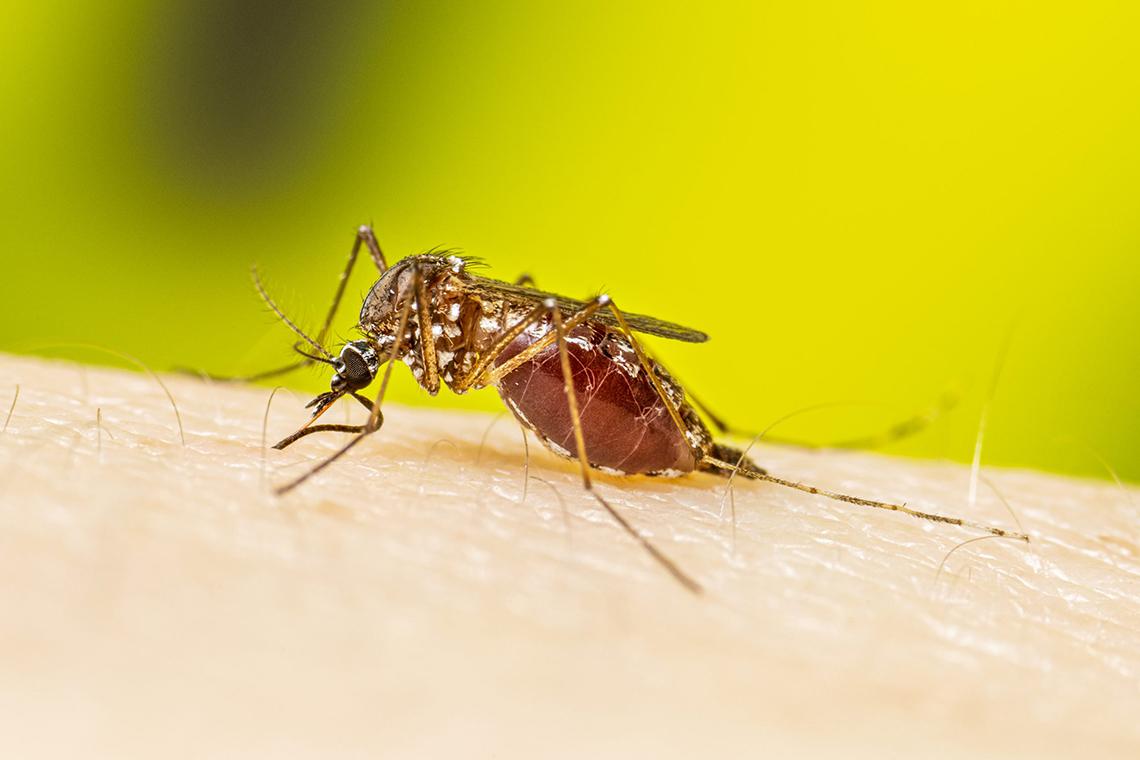A Buffet Bouquet?
Vosshall’s Research Reveals Some People Really Are Mosquito Magnets

Photo: Diana Gomez
No, you’re not imagining it. You might really be a “mosquito magnet.” And the smell of your skin is the reason, said Dr. Leslie Vosshall during a recent NIH Director’s Lecture in Lipsett Amphitheater.
“There’s nothing that we can do about any of this,” said Vosshall, the Howard Hughes Medical Institute vice president and chief scientific officer and Robin Chemers Neustein professor and head of the Laboratory of Neurogenetics and Behavior at Rockefeller University.
Each year, Aedes aegypti mosquitoes infect an estimated 400 million humans with the dengue virus while they get a blood meal. In addition to dengue, they transmit viruses such as yellow fever, Zika virus, and chikungunya.
Another species of mosquitoes, Anopheles, account for 500,000 deaths per year by spreading the malaria parasite. They require non-existent winters, standing water and close proximity to a dense human population. As the climate warms, northern and temperate regions are becoming “fantastic habitats” for the insect.
Mosquitoes are one of the few insects to evolve a taste for human blood, an “incredibly protein-rich meal.” Only female mosquitoes have the desire to bite humans because the female bugs require a blood meal to develop eggs, Vosshall said. In addition to cells, protein and lipid, blood contains glucose, sodium chloride, sodium bicarbonate and adenosine triphosphate, or ATP for short, which is a compound that provides energy to cells.
“ATP is one of the most exciting tastes that an insect ever encounters,” she noted. “It triggers feeding. They love the taste of it.”

Photo: CDC
In addition to blood, both male and female mosquitoes drink plant floral nectar for energy. Nectar contains sucrose, fructose and glucose. Females can tell the difference between nectar and blood even though they both contain glucose.
“Mosquitoes have two separate tongues—a tongue for blood and a tongue for sugar,” she said. One is the stylet and the other is the labium. They also have two stomachs—the crop, which holds sugar, and the midgut, which holds blood. If sugar enters through the midgut, the reproduction process is interrupted.
Female mosquitoes’ syringe-like stylet contains 25 neurons. “Half of these cells get really excited by the taste of blood,” Vosshall said. It’s not yet known what the rest do.
In one experiment, Vosshall’s lab genetically modified mosquitoes so they could see what neurons in the stylet activated during feeding. Mosquitoes were fed glucose, sodium chloride, sodium bicarbonate and ATP.
Results suggested that clusters of neurons responded to only one component of blood. A whole set of cells, for example, responded only to ATP. Then, there are neurons that respond only to sodium chloride or bicarbonate. In addition, there is one group of neurons called Integrators that responds to glucose when sodium chloride or bicarbonate is also present.

Photo: Diana Gomez
“If you do not have a blood component, these Integrator cells do not get excited,” she said. This mechanism ensures that the stylet does not confuse blood with nectar.
The pesky bugs are attracted to carbon dioxide, human body heat and odor. Carbon dioxide is the most potent arousal signal for mosquitoes. “A few seconds of carbon dioxide will flip them into a state of arousal for 15 minutes,” Vosshall said. “It doesn’t even matter if you run away. They’re still excited and will keep hunting you.”
There are many studies from both the lab and the field that show that certain people are more attractive than others. It’s thought that odor attracts mosquitoes to certain people because everyone produces carbon dioxide.
To answer the question of who’s more attractive to a mosquito, Vosshall’s lab at Rockefeller held a “March Madness”-style single elimination tournament where they pit the odors of volunteers against one another. They asked volunteers to wear nylon stockings with the toes cut off on their forearm for six hours.
“It’s a well-known secret in the field of chemical senses that nylon is the premier material to collect human body odor,” she explained. “It’s also cheap and commercially available.”
They cut the worn nylon into squares and placed one into each of two traps attached to a large box containing 50 unfed mosquitoes. The lab asked match-up winners to return and submit additional odor samples. The researchers continued these match ups for the next several months. The tournament’s winner—subject 33—was 144 times more attractive compared to the least attractive person, she said. The winner’s attractiveness remained steady throughout the tournament.
“The property of being highly magnetic to mosquitoes was extremely consistent,” she said. “Over the entire course of the study, there was never a game that subject 33 lost.”
The most attractive subjects in the experiment had higher levels of carboxylic acids on their skin. The acid is produced through sebum, an oily layer that coats a person’s skin. Beneficial bacteria eat the sebum and produce carboxylic acid and, as a result, an odor that smells like stinky cheese.
“Having high levels of carboxylic acids on your skin changes something about how attractive you are,” Vosshall said.
It’s possible that one day scientists might be able to alter the skin chemistry to make these magnets less attractive to mosquitoes, she noted. Vosshall hopes that her findings will lead to treatments that alter a mosquito’s taste for blood.
“It’s an important problem to figure out how these females are doing what they do and how do we stop them,” she said.
